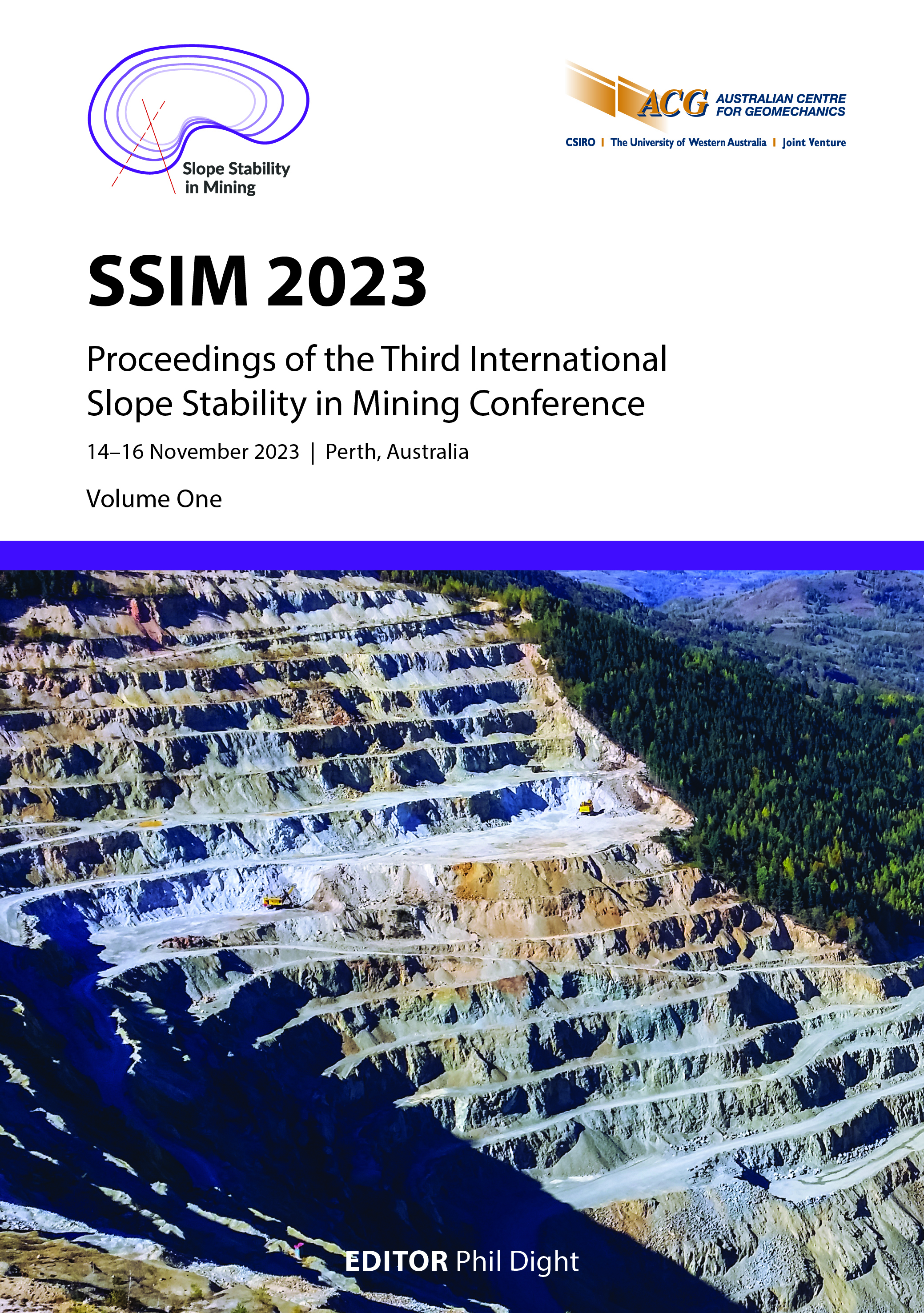Geotechnical model development in a geologically complex porphyry setting: East Wall, Ok Tedi Mine, Papua New Guinea

|
Authors: Jones, BR; Kennedy, G; Alickson, CL; Pahina, G |
DOI https://doi.org/10.36487/ACG_repo/2335_11
Cite As:
Jones, BR, Kennedy, G, Alickson, CL & Pahina, G 2023, 'Geotechnical model development in a geologically complex porphyry setting: East Wall, Ok Tedi Mine, Papua New Guinea', in PM Dight (ed.), SSIM 2023: Third International Slope Stability in Mining Conference, Australian Centre for Geomechanics, Perth, pp. 215-230, https://doi.org/10.36487/ACG_repo/2335_11
Abstract:
The Ok Tedi Copper-Gold Mine is one of the largest and most geotechnically challenging open cut pits in the world. The mine is the ‘wettest’ in the world and is situated in a complex geological setting typical of porphyrystyle deposits. Fundamental to successful pit slope designs at Ok Tedi is the understanding of the geotechnical model, with the development of the East Wall cutback model presented in this paper. The cutback is complicated by the presence of important mine infrastructure near the crest of the pit wall and significant ore reserves hosted within the lower pit wall, dipping parallel with the design. A high confidence geotechnical model was therefore required to balance geotechnical stability with the steepest possible design to maximise ore recovery. Tight operational time frames and ore flow requirements further complicated the model development process, and meant investigations and assessments were undertaken during mining operations. To achieve this, the geotechnical model was developed and refined during mining using the mine engineering geological model (EGM) knowledge framework. An initial model was developed using available data which highlighted a very complex zone formed by regional-scale deformation and deposit-scale brecciation, alteration, weathering and adverse structure developed during multiple intrusion events. These resulted in poor rock mass conditions, with the wider poor zone being known as the Ok Ningi Weak Zone (ONWZ). The presence of faults and shears towards the base of the ONWZ was identified as a major risk to the design and further monitoring, investigation and assessment during mining was required. Accelerating slope movements observed in the prism data during mining and the exposure of discrete, persistent, low strength sub-horizontal faults and shears confirmed the risk that these features posed to the design. The EGM process was used to quantify the risk with additional targeted field mapping campaigns, and review of existing and new borehole data was used to update the geotechnical model. This work confirmed the presence of adverse faults and poor zones at the base of the ONWZ. However the tactile conditions and spatial distribution of these structures and zones were found to be highly variable, and with low strength infills localised to pockets and lenses. This work along, with subsequent analyses, confirmed that the design risks were acceptable; even leading to optimisation of the ONWZ into two subdomains, one of which was steepened to reflect the improved understanding of rock mass and structural conditions. The EGM framework was used successfully to underpin engineering decisions throughout the investigation, modelling, analysis and design process despite geotechnical and operational challenges. The outcome of the geotechnical model development process was an optimised slope design incorporating an understanding of the stability risks.
Keywords: geotechnical model, engineering geological model, structural model, porphyry copper deposit
References:
Baynes, FJ & Parry, S 2022, Guidelines for the Development and Application of Engineering Geological Models on Projects, International Association for Engineering Geology and the Environment Commission, vol. 25, publication no. 1.
Casagrande, D, Klawitter, M & Koek, M 2021, ‘Monitoring and risk-control of large-scale toppling failures-a case study from Ok Tedi’, IOP Conference Series: Earth and Environmental Science, vol. 833, no. 3.
Eggers, MJ & Bertuzzi, R 2020, ‘The engineering geological model’, in R Bertuzzi (ed.), Tunnel Design Handbook, 4th edn, PSM, Sydney, pp. 5–13.
Hill, KC, Kendrick, RD, Crowhurst, PV, & Gow, PA 2002, ‘Coppergold mineralisation in New Guinea: tectonics, lineaments, thermochronology and structure’, Australian Journal of Earth Sciences, vol. 49, no. 4, pp. 737–752.
Hill, KC & Hall, R 2003, ‘Mesozoic-Cenozoic evolution of Australia’s New Guinea margin in a west Pacific context’, Defining Australia: the Australian Plate as Part of Planet Earth: Geological Society of America and Geological Society of Australia, joint publication, vol. 372, pp. 265–290.
Kennedy, G & Casagrande, D 2020, ‘Evolution and management of large-scale instability: a case study from Ok Tedi’, in PM Dight (ed.), Slope Stability 2020: Proceedings of the 2020 International Symposium on Slope Stability in Open Pit Mining and Civil Engineering, Australian Centre for Geomechanics, Perth, pp. 265–280,
Large, SJE, von Quadt, A, Wotzlaw, JF, Guillong, M, & Heinrich, CA 2018, ‘Magma evolution leading to porphyry Au-Cu mineralization at the Ok Tedi deposit, Papua New Guinea: trace element geochemistry and high-precision geochronology of igneous zircon’, Economic Geology, vol. 113, no. 1, pp. 39–61.
Mason, RA 1994, Structural Evolution of the Western Papuan Fold Belt, Papua New Guinea, PhD thesis, University of London, London.
Pollard, PJ, Jongens, R, Stein, H, Fanning, CM, & Smillie, R 2021, ‘Rapid formation of porphyry and skarn copper-gold mineralization in a postsubduction environment: Re-Os and U-Pb geochronology of the Ok Tedi Mine, Papua New Guinea’, Economic Geology, vol. 116, no. 3, pp. 533–558.
Weir, FM, Smith, AG, Watton, J, Koek, M & Kuira, P 2018, ‘Managing large scale failures – a case study from Ok Tedi mine, Papua New Guinea’, Slope Stability 2018: Proceeding of the XIV Congreso International de Energia y Recursos Minerales, Sevilla,
pp. 1394–1407.
© Copyright 2025, Australian Centre for Geomechanics (ACG), The University of Western Australia. All rights reserved.
View copyright/legal information
Please direct any queries or error reports to repository-acg@uwa.edu.au
View copyright/legal information
Please direct any queries or error reports to repository-acg@uwa.edu.au

